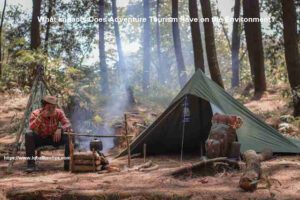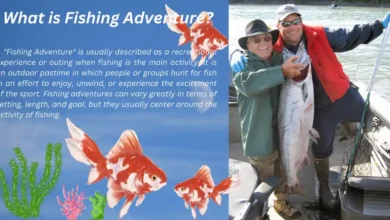
Impacts of Adventure Tourism on Environment
 |
Can you visit a remote wilderness without making any negative impact? It may seem like the obvious answer is no, but adventure tourism doesn’t have to come at the expense of the environment. By learning about the common impacts of adventure tourism and how to address them, you can enjoy all that nature has to offer while protecting it at the same time.
Introduction:
Adventure tourism is a growing industry worldwide. While there are many positive aspects to this type of tourism, there are also potential negative impacts that need to be considered. In this blog post, we’ll take a look at some of the ways adventure tourism can impact the environment, both positively and negatively. We’ll explore what these impacts are and how they may affect people and wildlife in the future.
The first potential impact would be on plants and animals. When an area has been used for an extended period of time, it often becomes difficult for native species to survive due to habitat degradation or competition with introduced species. For example, zebra mussels have caused major problems by clogging up water intake pipes and disrupting natural ecosystems.
The Positive Impact of Outdoor Activities:
Adventure tourism can have a positive impact on the environment. For example, it can promote physical activity, which has numerous health benefits. It can also lead to a greater appreciation for nature and a desire to protect natural resources. Furthermore, adventure tourism can create jobs and support local economies. Finally, adventure tourism can help people connect with each other and build strong communities.
The Negative Impact of Outdoor Activities:
Adventure tourism can also have negative impacts on the environment. For instance, many outdoor activities require heavy equipment such as backpacks, tents, and camping stoves. In order to maintain these items they need to be produced in factories that use energy sources such as coal or oil which emit pollutants into the air. Additionally, the materials used to produce these products often come from different parts of the world causing more pollution by using fossil fuels and air travel.
Impacts of Adventure Tourism on Economy
Adventure tourism is a growing industry with immense economic value. It is estimated that adventure tourism was worth $990 billion last year and is expected to grow to $1.6 trillion by 2026. This growth is largely due to the increasing popularity of outdoor activities and experiences, as well as the desire of travelers to seek out new and unique destinations.
According to UNWTO data, international tourist arrivals for all adventure travel categories grew from 38 million in 2010 to 52 million in 2020. By 2021, it is estimated that international tourist arrivals will reach 56 million people. The environmental impacts of this rapid growth are significant and not fully understood. Increased consumption of natural resources (fuel, water) by tourists can lead to increased levels of pollution. For example, rafting down an exotic river can cause erosion downstream when paddles stir up sediment or fishing lines snag plants along the banks.
Impacts of adventure Tourism on Wildlife
Adventure tourism can have both positive and negative impacts on wildlife. On the one hand, outdoor activities and eco-tourism can help raise awareness about the importance of conservation and can provide financial incentives to protect vulnerable species. On the other hand, some adventure activities can disturb or even harm wildlife. For example, off-road driving can damage sensitive habitats, and boating and rafting can disturb breeding sites and nesting areas.
However, regulations can be put in place to prevent these types of environmental impacts. The key is for adventurers to know when they’re treading into sensitive areas so that they can plan accordingly and minimize any potential impact on local wildlife. There are also guidelines for responsible travel which will allow you to get a better understanding of what impacts your actions may have.
Impacts of Adventure Tourism on Forest, and Mountain?
It is important to consider how your adventure tourism company might impact the environment. Depending on the type of adventure tourism you are engaging in, different parts of the environment will be affected. For example, if you are running a mountain biking company, you will need to consider how your biking will impact the trails.
If you are running a river rafting company, you will need to consider how your rafts will impact the riverbanks. As you can see, there are many factors to consider when impacts adventure tourism on the environment.
Simply put, there isn’t one answer to the impact of adventure tourism on the environment. The only way to make sure that your operation doesn’t negatively impact anything at all is through research and planning before starting an adventure tourism business or opening a new location for an existing one.
Impacts of Adventure Tourism on Endanger Species
There are many different ways that adventure tourism can impact adventure tourism on the environment. For example, some forms of adventure tourism include trekking through forests or hiking up mountains. This can lead to deforestation and soil erosion.
In addition, tour groups often leave behind litter, which can pollute water sources and attract animals that then become accustomed to humans and lose their natural fear of them. This can eventually lead to dangerous situations for both humans and animals.
Tourists should always be conscious of how they impact their surroundings when engaging in any form of outdoor activity. One way to do this is by limiting one’s party size. The fewer people there are, the smaller the impact will be on an area. It is also important to take care not to disturb local wildlife and refrain from feeding them.
Impacts of Adventure Tourism through Transport
Adventure tourism typically requires travel to and from remote locations, which can have a significant impact on the environment. For example, flying emits greenhouse gases that contribute to climate change, while driving releases harmful pollutants into the air. One way to reduce these impacts is by limiting the number of vehicles in an area at any given time.
Another approach is encouraging more people to use public transportation or carpooling instead of single-occupancy cars. Or encourage travelers to take trains, buses, boats, or other forms of transport that don’t release emissions into the atmosphere. It’s also important to remember that the environmental impacts of tourism occur all along the supply chain, so it’s important for tour operators to consider their operations’ environmental footprint and work with local suppliers who are committed to sustainable practices.
Impacts of Adventure Tourism on Local People:
While there are many positive impacts that adventure tourism can have on local people, there are also some negative impacts to consider. One of the biggest problems is that when tourists come to an area, they often displace the locals. This can lead to a loss of culture as well as a loss of income for locals who rely on tourism for their livelihoods.
In addition, the impact of adventure tourism can also be visible in the form increase in crime as well as litter and pollution. While these issues may not be directly caused by tourism, the increased influx of visitors leads to higher rates of these crimes. Furthermore, some regions become more popular than others because of tourism leading to even more displacement for locals.
The Economic Impacts of Adventure Tourism:
Adventure tourism is a growing industry with immense economic potential. According to a report by the World Travel and Tourism Council, the adventure tourism market is currently worth $653 billion and is expected to grow to $1.6 trillion by 2023.
However, this growth could trigger negative impacts of adventure tourism on the environment. The WHO estimates that each year, 230 million people are at risk of vector-borne diseases including malaria and dengue fever because of adventure travel. Another issue is natural resource degradation which affects water quality, soil quality, forest cover, and biodiversity loss. Many popular destinations such as Costa Rica’s Monteverdi cloud forest lost more than 90% of their tree cover in 50 years due to adventure tourism.
Conclusion:
The impacts of Adventure Tourism on the environment can be both negative and positive. On the positive side, adventure tourism can help to promote conservation efforts and sustainable practices. On the negative side, adventure tourism can lead to pollution and habitat destruction. The key is to ensure that adventure tourism is conducted in a way that minimizes its impact on the environment. One way of doing this is by following certain guidelines:
(1) Minimizing your stay,
(2) Minimizing your waste, and
(3) Minimizing your contact with wildlife.
These are all helpful steps that can minimize the impact of adventure tourism on the environment.
You may like:




